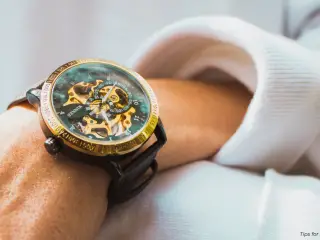 Luxury watches are timeless accessories that go beyond their function of telling time. They represent status and personal taste and often carry sentimental value. For collectors and casual buyers alike, a high-end timepiece from brands like Rolex, Omega, Patek Philippe, or Audemars People sees Piguet as a significant investment. Unfortunately, where there’s demand, there are counterfeits, and the market for fake watches is more sophisticated than ever. People no longer worry about shoddy knock-offs—some fakes boast such expert craftsmanship that even experts have to look twice.
Luxury watches are timeless accessories that go beyond their function of telling time. They represent status and personal taste and often carry sentimental value. For collectors and casual buyers alike, a high-end timepiece from brands like Rolex, Omega, Patek Philippe, or Audemars People sees Piguet as a significant investment. Unfortunately, where there’s demand, there are counterfeits, and the market for fake watches is more sophisticated than ever. People no longer worry about shoddy knock-offs—some fakes boast such expert craftsmanship that even experts have to look twice.
10 Tips for Spotting a Fake Watch
1. Examine the Case and Dial
The first thing to inspect on any watch is the case and dial, as they are among the most accessible places to spot flaws in counterfeits. Luxury brands use high-quality materials and pay meticulous attention to detail, which is where fakes falter. For example, genuine watches will have cases made of solid metals, such as stainless steel, titanium, or gold. At the same time, fakes may substitute these with cheaper metals or even plastic coated with a metallic finish.
When inspecting the case, check for any imperfections. Are there scratches on a supposedly new watch? Is the polishing uneven? A poorly finished watch case can be a sign that you’re looking at a counterfeit. Luxury watches should have a flawless finish, with no rough edges or visible seams where the metal parts meet.
The dial itself also holds clues. Fonts on luxury watches are consistent and clean, with crisp edges. Counterfeit watches may use a slightly different font that seems “off” when you compare it to the authentic version. Even the slightest difference in font size, weight, or spacing can be a giveaway. Logos and brand markings should also be centered, clear, and precise. For example, the Rolex crown logo must align perfectly, and the lettering should be crisp and clear, not fuzzy or blurred.
Additionally, the markers or numerals on a watch face should be spread evenly and attached securely. If the hour markers appear misaligned or are moving around when you tilt the watch, you’re likely dealing with a fake. Authentic watches, especially from high-end brands, never compromise on these details.
2. Inspect the Movement
A watch’s movement is its engine, and luxury watches are renowned for their intricate and precise movements. Brands like Rolex, Omega, and Patek Philippe use mechanical movements that are carefully assembled and decorated by skilled watchmakers. These movements are often a marvel of engineering, featuring components that work together flawlessly to keep time.
Most counterfeit watches, however, cut costs by using quartz movements or low-quality automatic movements that pale in comparison to the genuine article. Quartz movements are battery-powered and tend to have a distinct “ticking” motion in the second hand, whereas mechanical watches (both manual and automatic) have a smooth, sweeping motion. If the second hand on a luxury watch ticks rather than sweeps, that’s a clear sign of a fake unless the watch is known to have a quartz movement (like some Omega models).
Opening the case back can reveal even more. Genuine mechanical movements are beautifully finished, with engravings, jewels (synthetic ruby bearings), and complex gear assemblies. Fakes, on the other hand, might have a basic, unpolished movement that looks mass-produced. Some counterfeiters go as far as to add fake engravings or decorations on the movement, but these are often crudely done and easy to spot for a trained eye.
Moreover, many luxury watches, especially high-end models, have transparent case backs that allow you to see the movement. In these cases, the movement should look intricate, with every component serving a purpose. If the movement seems overly simplistic or poorly constructed, you’re probably holding a fake.
3. Assess the Bracelet and Clasp
The bracelet and clasp are other vital areas to scrutinize. Luxury watchmakers go to great lengths to ensure that their bracelets are both durable and comfortable, using high-quality metals, leather, or synthetic materials. A well-made bracelet will weigh it, feel sturdy in your hand, and feature links that move fluidly with no stiffness.
Counterfeit watches, in contrast, often have bracelets made from low-grade materials that feel light and flimsy. The links may be loosely assembled, with gaps or uneven spacing, making the bracelet feel cheap and prone to breaking. On metal bracelets, the surface should feel smooth, and there should be no sharp edges. If the bracelet pinches your skin or hair when you wear it, that’s a sign of poor craftsmanship and likely a fake.
The clasp, too, should be secure and easy to operate. Luxury brands often use proprietary clasps with engraved logos or unique mechanisms that are difficult to replicate. If the clasp feels loose, hard to open, or lacks the brand’s signature detailing, you may be looking at a fake. Some fakes will even have visible screws or pins in places where the original clasp would be seamless.
Moreover, check for engravings or serial numbers on the bracelet or clasp. These markings should be crisp and deeply etched, not shallow or faded. Fakes may attempt to replicate these, but they often miss the mark on quality.
4. Pay Attention to the Overall Appearance
There’s a certain aura about a luxury watch. When you hold one, you can often feel the difference in quality—everything from the weight, the materials, and even the way the watch reflects light can give you clues about its authenticity. Genuine watches have a heft to them because they use solid, premium materials. Watchmakers typically use sapphire crystal for the glass covering the dial, as it is highly scratch-resistant, instead of ordinary glass or plastic.
One simple test is to breathe on the crystal. Sapphire crystal is highly resistant to fogging, so if your breath quickly disappears from the surface, you’re likely dealing with an actual watch. If the fog lingers for a while, it could be a sign of lower-quality glass used in fakes.
Similarly, the overall design of the watch should be flawless. Many fakes look convincing at first glance, but on closer inspection, they often fall apart in the details. Look at the crown—luxury watches usually feature a logo engraved on the crown, and this should be perfectly aligned and finely detailed. Any misalignment or smudging of the logo is a red flag.
5. Be Wary of Suspiciously Low Prices
If something seems too perfect to be real, it most likely isn’t. A luxury watch carries a hefty price tag, and although you can find deals, they are usually insignificant. If you find a watch priced significantly lower than its retail value, be cautious. It’s common for counterfeiters to lure in buyers with unbelievably low prices.
For example, if you spot a Rolex Daytona selling for a fraction of its market price, you should raise your alarm bells. Some scammers also list fake watches on online auction sites with a low starting price to attract buyers. While you might think you’re getting a steal, you’re more likely buying a counterfeit.
It’s essential to understand the market value of the watch you’re interested in. Start by checking authorized dealers or reliable platforms that sell luxury watches. This tip will give you a ballpark figure of what the watch should cost. If someone offers you a much lower price, proceed with caution. The seller could be trying to offload a fake, and in some cases, buyers might only realize a scam once it’s too late.
6. Research the Seller
One of the most crucial steps in buying a luxury watch, primarily online, is to research the seller thoroughly. Reputable sellers, whether individuals or businesses, will have a track record of satisfied customers, and often, they’ll be authorized dealers for the brands they carry. When buying from an authorized dealer, you can be almost sure that the watch is genuine.
However, buying from an unauthorized source or private seller can be risky. Before making a purchase, look up reviews and feedback from other buyers. Does the seller have a history of positive transactions? Do they specialize in luxury watches? If you’re buying online, be wary of sites that have no customer service or clear return policy. Scammers often hide behind anonymity and disappear once they’ve made a sale, leaving you with no recourse.
If you’re buying in person, pay attention to the seller’s behavior. Are they pushy, reluctant to answer questions, or unwilling to provide documentation? A legitimate seller will usually be fine answering your queries and giving paperwork or proof of authenticity.
7. Compare with a Genuine Watch
If you have access to a known genuine version of the watch you’re considering, use it as a comparison tool. Whether you have it in your collection or can find it at a retail store, side-by-side comparisons can be incredibly helpful in identifying differences in design, weight, and craftsmanship.
For example, many fake Rolex Submariners are excellent replicas from a distance, but when placed next to a genuine Submariner, differences start to appear. You might notice slight discrepancies in the size or shape of the crown, the texture of the bezel, or the tone of the gold used in two-tone models. Even something as small as the date window could look different when compared directly.
In addition, many luxury brands have specific features that are difficult to replicate. Omega watches, for example, have laser-engraved logos that are virtually impossible for counterfeiters to copy with the same precision. Comparing a suspected fake with an authentic watch will make these differences much more apparent.
8. Consult an Expert
When in doubt, seeking the advice of an expert can save you from making a costly mistake. Watchmakers, appraisers, and even experienced collectors can provide valuable insights into the authenticity of a timepiece. Many high-end watch retailers also offer authentication services for a fee, and it’s often worth the extra cost to ensure you’re getting what you pay for.
Experts have access to tools and knowledge that the average buyer doesn’t. They can open up the case back to inspect the movement, examine serial numbers under magnification, and even use UV light to check for hidden security features that brands like Rolex include in their watches. An expert’s eye can spot subtle discrepancies that could otherwise go unnoticed.
If you’re considering purchasing a watch worth thousands of dollars, paying for an authentication service is a small investment to avoid a scam. And if the seller hesitates or refuses to let an expert examine the watch, that’s a major red flag.
9. Check the Warranty
A genuine luxury watch often comes with a warranty that covers the timepiece for a certain period, typically between 2 and 5 years. The manufacturer or the authorized dealer from which you purchased the watch usually provides this warranty. If the seller doesn’t give a valid warranty card or is offering a “grey market” warranty that seems unofficial, it’s worth digging deeper. Many fakes either don’t come with any warranty at all or provide a fake or expired one that doesn’t check out when verified.
Manufacturers often provide serial numbers and warranty information that you can verify through their official channels. For instance, Rolex, Omega, and Breitling allow buyers to check the authenticity of their watches by using the serial number or contacting an authorized dealer.
A valid warranty is one of the most evident signs of authenticity, so always ask for the original warranty documentation. If the watch is secondhand, ensure that the warranty is transferable or that the manufacturer can verify it. If the seller is hesitant or vague about the warranty details, it could be a sign that they’re hiding something.
10. Trust Your Instincts
Your instincts are your best defense. If something about the transaction feels off—whether it’s the price, the seller’s behavior, or even the watch itself—it’s worth taking a step back and reconsidering. Luxury watches are significant investments, and it’s better to be cautious than to rush into a bad deal.
If the watch feels too light, looks too shiny, or the seller is offering a price that’s too good to be true, don’t ignore those red flags. The internet hosts numerous stories of buyers who regretted their purchases because they ignored their instincts. Walking away from a suspicious deal is always a better option than ending up with a fake watch, which could be worth nothing in the long run.
In a world where counterfeits are becoming increasingly convincing, being able to spot a fake watch requires a keen eye for detail and a good amount of research. By following these ten tips, you can significantly reduce your chances of being tricked by a counterfeit watch seller. Remember, when it comes to luxury watches, knowledge is power. Educating yourself and taking the time to carefully inspect any watch before buying it will help ensure that your investment is indeed worth it. After all, there’s nothing quite like the feeling of owning a genuine piece of horological history.
















